
Cunard Line is a British shipping and cruise line based at Carnival House at Southampton, England, operated by Carnival UK and owned by Carnival Corporation & plc. Since 2011, Cunard and its three ships have been registered in Hamilton, Bermuda.

RMS Caronia was a 34,183 gross register tons (GRT) passenger ship of the Cunard Line. Launched on 30 October 1947, she served with Cunard until 1967. She was nicknamed the "Green Goddess" after her light green hull livery. She was one of the first "dual-purpose" ships, built both for 2-class transatlantic crossings and all 1st-class cruising. After leaving Cunard she was briefly Caribia in 1969, after which she was laid up in New York until 1974, when she was sold for scrap. While being towed to Taiwan for scrapping, she was caught in a storm on 12 August. After her tow lines were cut, she repeatedly crashed on the rocky breakwater outside Apra Harbor, Guam and broke into three sections.

Celestyal Crystal is a cruise ship, operated between 2007 and 2023 by the Cyprus-based Louis Group's Louis Cruise Lines and Celestyal Cruises. The ship was originally built as the cruiseferry Viking Saga in the 1980 at Wärtsilä Perno Shipyard and Turku Shipyard, Turku, Finland for Rederi Ab Sally. In 1986 she was renamed Sally Albatross, and rebuilt into a cruise ship the following year. The ship was destroyed by a fire in 1990, and completely rebuilt at Finnyards, Rauma, Finland. She was re-delivered in 1992, still named Sally Albatross. After partially sinking 1994 she was rebuilt at Industrie Navali Meccaniche Affini, La Spezia, Italy, re-entering service as Leeward for Norwegian Cruise Line. Subsequently she sailed as SuperStar Taurus for Star Cruises, Silja Opera for Silja Line. After being temporarily renamed Opera she was in service with Louis Group as Louis Cristal and later Celestyal Crystal.
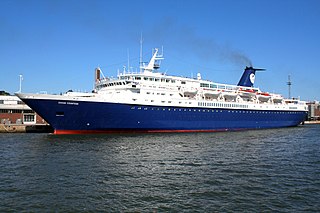
Ocean Countess was a cruise ship owned by Majestic International Cruises of Greece. She was completed in 1976 as Cunard Countess for Cunard Line and was a popular ship in the Caribbean cruise market for 20 years. After leaving Cunard service in 1996, she had a number of owners before being purchased by Majestic in 2004. She was retired in 2012 and scrapped in 2014 after a fire destroyed the ship.
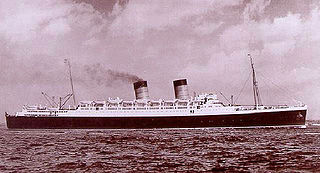
RMS Mauretania was an ocean liner that was launched on 28 July 1938 at the Cammell Laird yard in Birkenhead, England, and was completed in May 1939. She was one of the first ships built for the newly formed Cunard-White Star company following the merger in April 1934 of the Cunard and White Star Line. On the withdrawal of the first Mauretania in 1935, to prevent a rival company using the name and to keep it available for the new liner, arrangements were made for the Red Funnel paddle steamer Queen to be renamed Mauretania in the interim.

RMS Caronia was a Cunard Line transatlantic steam ocean liner. She was launched in 1904 and scrapped in 1932. In World War I she was first an armed merchant cruiser (AMC) and then a troop ship.
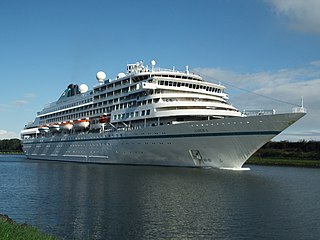
MS Amera is a cruise ship operated by Phoenix Reisen. She was launched in 1988 as Royal Viking Sun for Royal Viking Line, and began operating for Cunard Line under the same name in 1994. She was renamed Seabourn Sun when Seabourn Cruise Line acquired the ship in 1999. In 2002, Seabourn transferred the ship to Holland America Line, which was renamed as Prinsendam. In 2018, Prinsendam was sold to Phoenix Reisen, debuting in 2019.

SS Southern Cross was an ocean liner built in 1955 by Harland & Wolff, Belfast, Northern Ireland for the United Kingdom-based Shaw, Savill & Albion Line for Europe—Australia service. In 1975 she was rebuilt as a cruise ship and subsequently sailed under the names Calypso, Azure Seas and OceanBreeze until 2003 when she was sold for scrap to Ahmed Muztaba Steel Industries, Chittagong, Bangladesh.

MSMarella Dream was a cruise ship built in 1986 at the Meyer Werft shipyard in Papenburg, West Germany as Homeric for Home Lines, and their last newbuild to remain in active service. In 1988 she was sold to Holland America Line, renamed Westerdam, and in 1990 lengthened by 36.9 m at Meyer Werft. In 2002 she was transferred to the fleet of Costa Cruises and renamed Costa Europa. In April 2010 she was taken on a ten-year charter by Thomson Cruises, under the name Thomson Dream.

RMS Transvaal Castle was a British ocean liner built by John Brown & Company at Clydebank for the Union-Castle Line for their mail service between Southampton and Durban. In 1966 she was sold to the South Africa-based Safmarine and renamed S.A. Vaal for further service on the same route. Following cessation of the service between the UK and South Africa in 1977 the ship was sold to Carnival Cruise Line and rebuilt in Japan as the cruise ship SS Festivale, re-entering service in 1978. In 1996 she was chartered to Dolphin Cruise Line and renamed IslandBreeze. In 1998 the ship was sold to Premier Cruise Line, which renamed her The Big Red Boat III. Following the bankruptcy of Premier Cruise Line in 2000, The Big Red Boat III was laid up until 2003 when she was sold to scrappers in Alang, India. She was renamed The Big Red Boat for her final voyage to the scrapyard.

The Royal Viking Line was a luxury cruise line that operated from 1972 until 1998. The company was the brainchild of Warren Titus and had its headquarters at One Embarcadero Center in San Francisco.

MV Georgic was the last ship built for the White Star Line before its merger with the Cunard Line. Built at Harland and Wolff shipyard in Belfast, she was the running mate of MV Britannic. Like Britannic, Georgic was a motorship, and not a steamer, fitted with a diesel powerplant. At the time of her launch in 1931, she was the largest British motorship.
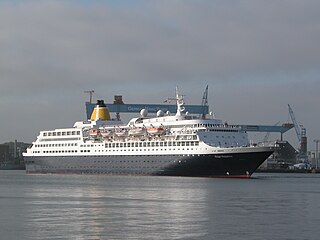
Blue Sapphire is a cruise ship owned and operated by ANEX Tour. She was originally built in 1981 by Bremer Vulkan of Germany for Hapag-Lloyd Cruises as Europa. In 1999, Europa was sold to Star Cruises and she was renamed SuperStar Europe and a year later, Superstar Aries. In 2004, she was sold to Pullmantur Cruises and renamed Holiday Dream. In May 2008, she was transferred to the fleet of CDF Croisières de France and renamed Bleu de France. In November 2010, she was sold to Saga Cruises, but retained on charter by CDF for a further 12 months. Following an extensive refit in Italy from November 2011 to March 2012, the vessel was renamed Saga Sapphire. Most recently, she was sold to ANEX Tour in June 2020 and renamed Blue Sapphire, scheduled for an official debut in 2021.

RMS Sylvania was an ocean liner built in 1957 by John Brown & Co (Clydebank), in Glasgow, for the United Kingdom-based shipping company Cunard Line. She was the last Cunard Line vessel built specifically for transatlantic crossings. The ship was later heavily rebuilt as a cruise ship, and sailed under the names SS Fairwind, SS Sitmar Fairwind, SS Dawn Princess and SS Albatros before being scrapped in 2004. She was renamed SS Genoa for her last voyage.

MS Cunard Princess was a cruise ship, previously owned an operated by the Israel-based Mano Maritime. She was built 1975 by the Burmeister & Wain shipyard in Copenhagen, Denmark for Cunard Line as MS Cunard Conquest, but her interior fittings were subsequently installed at the Navali Mechaniche Affini in La Spezia, Italy. Following re-delivery from Navali Mechaniche Affini in 1977 the ship was renamed MS Cunard Princess. In 1995, the ship entered service with StarLauro Cruises, briefly retaining her previous name before being renamed MS Rhapsody. In 2009 she was sold to Mano Maritime and sailed as Golden Iris until 2018. After being laid up for four years at Chalkis Shipyard, Greece. In 2021 was she renamed Gold Club. She was beached at Aliağa, Turkey, for recycling.

MS Sagafjord was an ocean liner built in 1965 by Société Nouvelle des Forges et Chantiers de la Méditerranée for Norwegian America Line as a combined ocean liner/cruise ship. Between 1983 and 1996 the Sagafjord was operated by Cunard Line. In 1996–1997 she was briefly operated by Transocean Tours as MS Gripsholm prior to being sold to Saga. She was last owned and operated by Saga Cruises on worldwide cruises targeted at the senior market out of the United Kingdom, known as the MS Saga Rose. She was retired in 2009 and scrapped in 2010.

RMS Ivernia was a Saxonia class ocean liner, built in 1955 by John Brown & Company in Clydebank, Scotland for Cunard Line, for their transatlantic passenger service between the UK and Canada. In 1963 she was rebuilt as a cruise ship and renamed RMS Franconia, after the famous pre-war liner RMS Franconia. She continued to sail for Cunard until being withdrawn from service and laid up in 1971. In 1973 she was sold to the Soviet Union's Far Eastern Shipping Company and, renamed SS Fedor Shalyapin, cruised around Australia and the far East. In 1980 she was transferred to the Black Sea Shipping Company fleet, and for a time returned to cruising in the Mediterranean and around Europe. In 1989 she was transferred again, to the Odessa Cruise Company, and continued her career as a cruise ship until 1994. She was then laid up at Illichivsk, a Black Sea port 40 km southwest of Odesa, until 2004 when, as the Salona, she sailed to Alang, India, where she was scrapped.

MS Astor was a cruise ship that most recently sailed for Cruise & Maritime Voyages' Transocean Cruises subsidiary, under which she operated voyages to Europe, South Africa, and Australia.
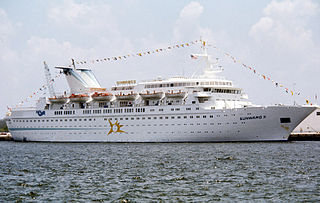
MV Cunard Adventurer was a cruise ship built was a Cunard Line and operated from 1971 to 1977. She was the first of the company's vessels in the 20th century to bear a name that did not end in "ia" or begin with "Queen."
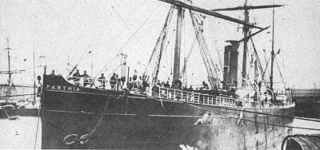
SS Parthia (1870–1956) was an iron-hulled transatlantic ocean liner built for the Cunard Line by William Denny and Brothers in Dumbarton, Scotland. Her sister ships were the Abyssinia and Algeria. Unlike her two sisters, Parthia was smaller, built in a different shipyard and had a slightly different funnel arrangement. The Parthia was retired by Cunard in 1883 and sold to John Elder & Co., who subsequently transferred her to the Guion Line. After serving with the Guion Line and operating on trans-Pacific routes with the Canadian Pacific Railway Company, she was refitted and renamed Victoria.

























